InDesign and InCopy Play Well Together
InDesign is now about 10 years old. It was a beautiful child, able to set lovely type. But that was about all. Around 2004, it had developed to the point that I was telling clients InDesign was the future. Around that time I met Wil Eisley, the product manager for InDesign, and he commented that the original release was a decent "proof of concept", but not particularly useful in the real world. At 10, InDesign is still a beautiful child, but now capable of performing some impressive magic tricks.
Click any of the images here for a full-size view.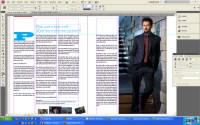
From the outside, InDesign CS4 and InCopy CS4 don't look a lot different from the CS3 versions. Looks are deceiving, though. Although there are some welcome new features that will be immediately obvious to users, most of the work on this version was done behind the scenes. This includes a complete rewrite of some major parts of InDesign's infrastructure. And, indeed, the infrastructure of the entire suite because all of the applications run on the same code base.
What that means in plain English is that if multiple CS4 applications need to perform the same task (rendering a photographic image on the screen, for example) each application calls the same section of code from what you can think of as a large library of routines. This approach has many advantages, and the two most significant are probably consistency across the suite and the need to write code to perform a specific task just once.
ALL ARTICLES IN THIS SERIES
I will add links to this sidebar as I complete reviews.
Introduction, Installation, and Bridge
Photoshop
InDesign and InCopy
Dreamweaver
Acrobat
Soundbooth and Audition
Adobe's video applications
Flash and Fireworks
Illustrator
As I've mentioned a time or two in programs dealing with other parts of Creative Suite 4, Adobe is well positioned with tools to cover every type of communication, from print and the Web to audio and video. This is the result of an aggressive acquisitions program and, most recently, the merger with Macromedia. Not every merger goes well, but teams from Adobe and Macromedia seem to have learned how to work together very well.
Creative Suite 3 was released following the merger, but not long enough after the merger for us to see where the company would go. Integration between applications in CS3 was impressive given the amount of time the teams had to accomplish what they did, but integration in CS4 is far better.
I talked with InDesign and InCopy senior product manager Michael Ninnes and we discussed the ability of InDesign, InCopy, and other applications in the Creative Suite to accept plug-ins and extensions from other software developers. This is a technique that allows the addition of new features to the applications. One important point to understand is that many extensions for InDesign also work with InCopy.
- Michael Ninnes of Adobe: LISTEN (7 minutes 25 seconds)
We also spent some time considering the new features of InCopy and how it works to speed the workflow by allowing editors and designers to work on the same document simultaneously.
- Michael Ninnes of Adobe: LISTEN (3 minutes 28 seconds)
Working Together
 Here's a quick (and very simple) example of how InDesign and InCopy work together. From InDesign, the document creator needs to establish an assignment.
Here's a quick (and very simple) example of how InDesign and InCopy work together. From InDesign, the document creator needs to establish an assignment.
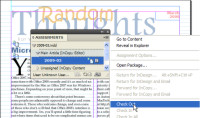 Next, the InCopy user opens the document. In this case, the InCopy user is allowed to edit any of the text in the main article, but cannot touch any other text or any of the graphics.
Next, the InCopy user opens the document. In this case, the InCopy user is allowed to edit any of the text in the main article, but cannot touch any other text or any of the graphics.
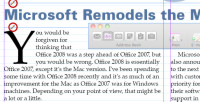 Once the InCopy user checks out the document (the pencil icons indicate editing is possible), InCopy can edit the document but the InDesign user will no longer be able to edit the text. At this point, the InDesign user could be working on other parts of the document.
Once the InCopy user checks out the document (the pencil icons indicate editing is possible), InCopy can edit the document but the InDesign user will no longer be able to edit the text. At this point, the InDesign user could be working on other parts of the document.
 The InCopy user might examine the document in the story editor view to see how much text must be edited to make the document fit. In this case, it's not very much.
The InCopy user might examine the document in the story editor view to see how much text must be edited to make the document fit. In this case, it's not very much.
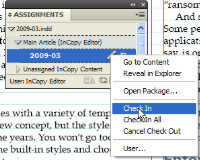 Once the InCopy editor has fit the copy to the design, it's important to check the document back in so that the designer can continue working with it in InDesign.
Once the InCopy editor has fit the copy to the design, it's important to check the document back in so that the designer can continue working with it in InDesign.
 The the left, you see the view from InDesign while the InCopy editor has the document checked out. Until the InCopy editor checks the document back in, the InDesign user can modify graphics or other parts of the document, but cannot touch the main article.
The the left, you see the view from InDesign while the InCopy editor has the document checked out. Until the InCopy editor checks the document back in, the InDesign user can modify graphics or other parts of the document, but cannot touch the main article.
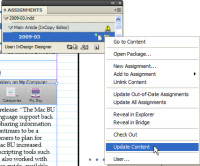 After the InCopy editor checks the story back in, the InDesign user needs only to update the content to see the changes. (At right.)
After the InCopy editor checks the story back in, the InDesign user needs only to update the content to see the changes. (At right.)
Flash from InDesign
People who design documents for print increasingly are being asked to create something for use on a website, but writers and print designers often aren't proficient in HTML or Web technologies. That makes InDesign's ability to create a Flash file particularly welcome. The Flash output from InDesign reminds me of what Corel's now discontinued R.A.V.E. application produced. The files were compressed Flash movies that would play, but didn't have what was needed to be imported into Flash and be modified.
Adobe partially solved that problem with a new file format, XFL, which is an interchange file format. Save the Flash presentation from InDesign as XFL and then open it in Flash for editing.
I said "partially solved" because the XFL format allows you to import the presentation into Flash and edit it, but most of animations and transitions that you might have created in InDesign will be gone. You'll need to recreate those in Flash. It's still far better than having to start from scratch. And solving the rest of the problem may be something for Adobe's programming staff to work on for a future release.
Animations in a Print Application?
Yes. If you're designing strictly for print, you won't use the transitions, of course. But few designers design just for print these days. Magazines, newspapers, and even books are often ported to or adapted to the Web. So if the publication will be going to the Web, the designer can create page-turn effects, dissolves, wipes, and fades.
Another feature that's meaningless in a print-only world is the ability to create hyperlinks. But if the designer needs to create a PDF or target the information for the Web, this can be a huge time saver. To create a hyperlink, just select some text and add a URL in the hyperlink panel. This panel also allows the application of styles so that hyperlinks will be consistent across the publication. And, if the destination is a PDF, you may want to highlight the link with a surrounding box; if not, you'll probably suppress the box.
These are features that clearly illustrate Adobe's understanding of modern communication. Any print document is almost sure to be used in at least one electronic format. InDesign is a superb tool for designing and preparing print documents, but the development team has its eye on what designers will need in the future.
Вы говорите по-русски? (I'm asking if you speak Russian.)
Globalization means that documents may need to be developed in several languages. InDesign's new conditional text feature is a plus here. (And, I have to say, this is one of the features that I begged for when I met with InDesign programmers back in 2004 or 2005.) Conditional text allows the user to show or hide specific bits of text, depending on some global document settings. You might need to show prices in dollars for the US market, pounds in Great Britain, euros in much of Europe, and rubles in Russia.
Or maybe you have a text book with a teacher's edition that needs to include teaching suggestions, answers to questions, and illustrations that aren't in the student copy of the book. Or a file that is used to produce both a wholesale and a retail version of a catalog.
Conditional text can be applied to paragraphs, words, or characters so that a single file can be used in place of multiple files (and in place of the ugly solution, multiple layers within a single file).
The Best Possible Output
Knowing what to expect is important to print designers. It's an imperfect world because the monitor represents colors using the RGB color space and print represents colors in the CMYK color space. Monitors add colors while printing on paper subtracts colors. The InDesign Preflight Panel manages preflight profiles. These profiles need to be matched to the expected output, so a profile might contain just the color space specification or it might include information about transparency blending, stroke weight, warnings about Pantone colors in a CMYK workflow, notices when more text was flowed into a document than will fit on the page, and more. The goal is for the designer not to have any unpleasant surprises after the project has been sent to the press. Or worse, after 1,000,000 copies have been printed.
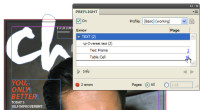 Live Preflight works rather like a live spelling checker: It's on all the time and provides immediate feedback when it senses a problem. This allows the designer to be aware of a problem early in the process and not have to scramble to fix a surprise problem following a 3 am panic phone call from the printer.
Live Preflight works rather like a live spelling checker: It's on all the time and provides immediate feedback when it senses a problem. This allows the designer to be aware of a problem early in the process and not have to scramble to fix a surprise problem following a 3 am panic phone call from the printer.
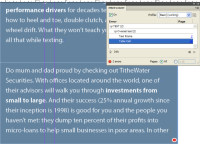 At the left, you see a live preflight check that shows two errors. Both are simple text overset errors (there's too much text for the space). If the InDesign user clicks the page number, InDesign goes to the page and shows the problem area. Note the red dot in the lower right corner.
At the left, you see a live preflight check that shows two errors. Both are simple text overset errors (there's too much text for the space). If the InDesign user clicks the page number, InDesign goes to the page and shows the problem area. Note the red dot in the lower right corner.
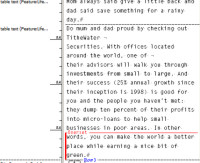 Opening the file in story view shows how much text is overset. The editor or designer can work in this view or in the more visual design mode.
Opening the file in story view shows how much text is overset. The editor or designer can work in this view or in the more visual design mode.
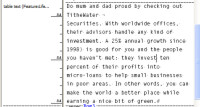 Both views have advantages. Using the story editor view, the editor can concentrate on the text without being bothered by the design. But the publication needs to look good, too, so the design view allows the editor to see the text as it will look on the page.
Both views have advantages. Using the story editor view, the editor can concentrate on the text without being bothered by the design. But the publication needs to look good, too, so the design view allows the editor to see the text as it will look on the page.
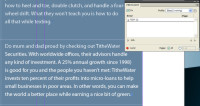 Using the design view allows the designer or editor to make final changes that serve both the text and the design.
Using the design view allows the designer or editor to make final changes that serve both the text and the design.
When the error condition has been resolved, InDesign removes the error warning from the window and the designer or editor can move on to the next problem. These are the kinds of features that speed the editing and design processes and allow the publication staff to create the best possible document in the least possible time.
Everyone wins, including the reader.
 Bottom Line: If print and Web designers aren't dancing in the streets, they should be.
Bottom Line: If print and Web designers aren't dancing in the streets, they should be.
When it was time set the rating for InDesign and InCopy, I found myself thinking of what the next version will look like, 8 to 20 months from now. I thought that 4 cats seemed right. But that seems unfair because of what these applications are able to do right now. So forgetting what magic Adobe might work in the future, today's versions of InDesign and InCopy clearly earn 5 cats. Or 6. Or maybe more. But 5 is as high as my scale goes. If you're using an earlier version, now is the time to upgrade. On that score, I'm not at all confused.
For more information, visit the Adobe InDesign and Adobe InCopy websites.
No, I Would Not Like to Be a Mystery Shopper
The message claimed to be from Garnett Dalton, but the e-mail address was for a "ncertiorari", it was signed by "Michael Bernard", and he said his e-mail address was "friedman519". So before I'd read any of the message, I knew it was a fraud. Of course, the fact that Garnett or Michael was thanking me for my interest in "the Mystery Shopper position" was a pretty good clue, too. I do not like to shop, so it's unlikely that I would apply for a "Mystery Shopper" position. The message had also been marked as spam, but it was Sunday and I was playing in the trash.
 Click any of the images here for a full-size view. What's the game? I wondered. Mystery shopper programs do exist, of course, and the spam told me that mystery shoppers are important because they observe how store employees "interact with customers during their normal daily routines." To be a mystery shopper, I would pose as an ordinary customer and "provide feedback of both factual observations ... and your own opinions."
Click any of the images here for a full-size view. What's the game? I wondered. Mystery shopper programs do exist, of course, and the spam told me that mystery shoppers are important because they observe how store employees "interact with customers during their normal daily routines." To be a mystery shopper, I would pose as an ordinary customer and "provide feedback of both factual observations ... and your own opinions."
"Our company partners with you to implement proven mystery shop auditing and surveying strategies that provide critical information about customer experiences," the spam said, promising that I would be paid "a commission of $100 for every duty you carry out, and bonus on your transportation allowance."
A bonus on my transportation allowance? Why are alarms ringing all around me at this point?
What kind of person can be a mystery shopper? They're looking for someone who is 21 years of age or older (check), loves to go shopping (urk!), is fair and objective (well, sometimes), is ON TIME (why the CAPITALS?), is very observant and able to focus on details (check), and is fairly intelligent (hmmmm). The shopper also need to be patient, detail oriented, practical, trustworthy, and discreet (at least they didn't ask me to be "discrete"). I would also have to handle deadlines, have full Internet access, and type well.
The message invited me to send my information to Michael Bernard at Best Surveys, 505 Barranca Parkway, Irvine, California, so that they could "look for locations in your area that needs to be evaluated."
Where?
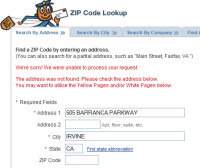 Google Maps and the US Postal Service are helpful in evaluating addresses and I quickly found that 505 Barranca Parkway doesn't exist in Irvine. The address would probably be in Santa Ana, except that the road ends before it gets there.
Google Maps and the US Postal Service are helpful in evaluating addresses and I quickly found that 505 Barranca Parkway doesn't exist in Irvine. The address would probably be in Santa Ana, except that the road ends before it gets there.
 So if I had any doubt about these folks being up to no good, the picture was now clear.
So if I had any doubt about these folks being up to no good, the picture was now clear.
A quick Google search revealed the scam for what it is. Someone who applied for one of the "jobs" quoted the response he received from "Michael Bernard":
"We are currently making evaluations for Visa to detect unsecure stores," the message said. "Your task is to find any store in your area which is part of the Visa system (they usually have the Visa logo in the window) but does not require PIN on transactions of over $1000."
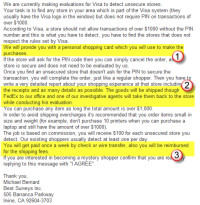 Bernard promised to "provide you with a personal shopping card which you will use to make the purchases." (1, at right) The card will, of course have my name on it. In fact, I imagine that it will be issued by the bank in my name when "Best Surveys" obtains enough information from me to request the card.
Bernard promised to "provide you with a personal shopping card which you will use to make the purchases." (1, at right) The card will, of course have my name on it. In fact, I imagine that it will be issued by the bank in my name when "Best Surveys" obtains enough information from me to request the card.
Bernard again: "If the store will ask for the PIN code then you can simply cancel the order, as the store is secure and does not need to be evaluated by us," (2, at right) the spam said. "Once you find an unsecured store that doesn't ask for the PIN to secure the transaction, you will complete the order, just like a regular shopper."
Then I would have to ship the item I purchased, along with all receipts and papers, via FedEx to Best Surveys so that "one of our investigative agents will take them back to the store while conducting his evaluation."
And I'll be paid once per week (3, at right).
Smell something fishy? Why would I ship goods to California so that their investigator can bring them back to a store in Ohio?
More quotations from the wondrous "Michael Bernard": "In order to avoid shipping overcharges it's recommended that you order items small in size and weight (for example, don't purchase 10 printers when you can purchase a laptop and still have the amount of over $1000). The job is based on commission, you will receive $100 for each unsecured store you detect. Our existing shoppers usually detect at least one per day."
So if I sign up, what's my status? Well, I would have a new credit card with at least one $1000 purchase on it, maybe more. And when the credit card company calls to ask if I had made the purchases, I would confirm that I had. (After all, I'm testing their security!) "Best Surveys" would have the goods and all the receipts and other paperwork so they can return them for credit, pawn them, or sell them outright on Ebay. When the credit card bill comes, I'll be the one on the hook and I won't be able to say that someone stole the card because I still have it.
Questions and Obfuscations
I receive questions and provide answers. Sometimes the answers actually have something to do with the question that was asked. Occasionally, the answer has the additional bonus of being correct.
How Much Computing Power Do I Need?
"I use my computer primarily for word processing and it's time to buy a new machine. I know that I'll need at least 4GB of RAM, but should the computer be dual-core or quad-core? I'm not concerned about the size of the disk drive because I'll keep files that I don't need very often on an external hard drive." It's hard to imagine more incorrect assumptions in a single question.
Let's start with RAM. You should install a maximum of 3GB RAM if you're running the 32-bit version of XP or Vista because 32-bit operating systems can use between 3 and 4GB, and that includes any memory on the video card. But the 64-bit versions of Vista and Windows 7 technically would be able to address 16.8 million terabytes (16 exabytes) of RAM. I say "technically" because nobody is making main boards that will accept that much RAM, nor are they likely to. The 64-bit versions of Vista and Windows 7 have an artificial limit of 128GB of RAM. So 4GB isn't a bad starting point if you know you'll be upgrading to a 64-bit version of Windows. Or maybe not. I'm hearing that Windows 7 works reasonably well with just 1GB of RAM. In any event, if you choose to install more RAM that your current operating system is able to use, you should probably know why you're doing that.
The idea of a 4 terabytes of physical memory, much less 16 exabytes of address space, is a bit mind-blowing. To help you wrap your head around the scale this involves, consider this: A DVD can hold 4.7GB of data and store more than 2 hours of high-quality MPEG-2 video. 250 DVDs can contain about a terabyte of data. The largest physical library in the world, the U.S. Library of Congress, contains about 20 terabytes of text. The Internet Archive, which maintains what it thinks it is a full copy of the information available on today's Internet, holds over a petabyte (1000 terabytes) of data and is growing at over 20 terabytes a month.
An exabyte could contain 1000 copies of today's Internet Archive.
Source: Apple.com (http://developer.apple.com/MacOsX/64bit.html)
Now let's consider the CPU. Word processors spend most of their time waiting for us to press a key, even if we type really, really fast. Set up a system monitoring tool to watch CPU usage when Word is open. Most of the time it'll be 95% to 99% "system idle process". What this means is that CPU power isn't a big deal unless you're working with audio, video, or large images. For normal use, a 2GHz dual core CPU with 2-3GB of RAM will be plenty. My computer, for example, is nearly 3 years old and I use some high-end audio applications (and, occasionally, some video applications). It's a 2.6GHz dual-core CPU with 2GB of RAM and a 768 MB video card.
As for hard drives, you won't find many disk drives under 100GB these days and many machines come with 500GB and 1TB drives. You'll be better off storing all your files on the main hard drive and using the external for backup. Otherwise, you'll have situations in which you're not sure where the file you want is and, if you have a copy on each drive, which is the most current.
Dude, Where's My File?
"I sent someone a Word file. They edited the file by opening it from their word processor. Now they can't find it even though it represents a day's worth of work for them."
Ugh! Of course, the person who edited the file should have, before typing even one character, performed as "save as" to place the file in a location where it could be found. But all is not lost.
I would try starting Word and examining the most recently used (MRU) list. The name may be there, but the e-mail program that was involved will control where temporary files are saved. I tried an experiment using Word 2007 on the office machine where I have to use Outlook as my e-mail client. The saved file went to "My Documents", a directory that I never use for anything.
The same experiment with another e-mail program, The Bat, would have saved the file in "C:\Documents and Settings\bblinn\Local Settings\Temp\bat\".
In both cases, the file would have been saved under the original name of the incoming document. Other applications may save the file in more obscure locations and with more obscure names.
The user might try loading the original file from the e-mail once again and then performing a "File, Save AS" to see where the application proposes storing the file. Do not actually save the file; use this exercise simply to figure out where to look for the previously edited file.
Two key points (beyond remembering "save as" as the first step) are to know what e-mail program is involved and to understand the application's behavior with regard to temporary files.
Mac or PC?
"Context: New desktop computer for a small membership association office. Old computer died suddenly. Never mind the data question. Never mind the user question. The real question is support and ease of use and durability of hardware and OS. Any reason why to not get a Mac instead of a PC? No programs used intensively and the only programs used are Word, Excel, and Quickbooks."
If you get a Mac, you'll need to obtain the Office 2008 versions of the Office suite. Note that there is not Mac version of Access. Alternatively, you can dual-boot the system Windows/Mac or triple-boot by including Linux.
I believe that Quickbooks doesn't have a Mac version, so dual-boot or running a Windows VM would be essential. (This turned out to be incorrect; Quickbooks does have a Mac version.)
Hardware is hardware, but Apple has more control than the average PC manufacturer. That said, I have a Windows laptop (Toshiba) that was once run over by a Ford Explorer (saved by a strong case) that is still running after 6 or 7 years and one of my old Windows desktops (I built using top-quality components) is still running at a friend's house and it's at least 10 years old. I also have a Mac notebook that serves as a glorified Ipod. I bought it in 2000.
A friend who is the chief technical officer for a company that deals with a lot of data just bought a MacBook and really likes it. He's also a Unix/Linux genius and the Mac is powered by BSD Linux.
The differences are many and varied, but an OS is an OS; they all serve the same purpose.
Nerdly News
Trust Nothing
You're minding your own business on Facebook (as much as you can mind your own business on Facebook) when suddenly you receive a message. It's an invitation to watch a video. Or an invitation to dinner. Or a notice that one of your friends "has faced some errors when checking your profile." You click the link that's provided and you're told that you must load or update the Adobe Flash plug-in. You click the link to do that. You've just been had.
The message may appear to have come from someone you know, but the Flash plug-in link is, of course, bogus. It's the latest iteration of the "Koobface" Worm and you may also find it on MySpace, Google Talk, LiveJournal, MyYearbook, Friendster, Hi5, Bebo, and other social networking sites.
When I said "you've been had", here's what I mean: The link runs an application that installs a Trojan horse program. That application gives the creeps who wrote the worm control over your computer. Trend Micro says that the worm will then start sending out similar requests purporting to be from you to to all of your contacts.
Be wary of anything that arrives by way of e-mail. Be doubly wary of anything that arrives at a semi-public social-networking address. The best advice is simply not to click links. If something tells you that you need the Adobe Flash player, go to the Adobe site by typing "www.adobe.com" and download the application from there.
If somebody who has never, ever invited you to dinner (and probably never will) sends a message inviting you to dinner and offering a link to click, don't click the link. Contact the person by some other means (phone, e-mail, telegram, walking by their office, carrier pigeon, ransom note, whatever) to confirm the invitation.
It's the Internet equivalent of being street smart.
A is for Apple, and Also for Amazon
Where do you go if you want to buy an electronic book for your Iphone or your Ipod Touch? You could of course go to the Apple store and that is what Apple would like you to do. But as of Wednesday, another choice was available: Amazon. You'll need to download a free application from Amazon, Kindle for Iphone and Ipod Touch, but then you'll have access to 240,000 e-books that Amazon.com sells.
Amazon is the nation's largest book seller and it clearly sees a trend developing, a trend away from physical books and toward electronic versions of books. That's why Amazon has its own reader device, the Kindle. But other devices such as those by Apple can also be used to read e-books. A phenomenon that I noticed when I started spending a lot of time in New York City in the mid 1980s is that people in New York read a lot. Newspapers are common on the subway, of course, but so are books. If books become something that everyone can carry in a device they already take with them wherever they go, this trend could spread.
Devices such as the Kindle, Iphone, or Ipod Touch are ideal for those kinds of situations in which you would consider reading if you had a book handy—maybe waiting in a doctor's office or standing in line at the grocery store or bank (for those few people who actually still go inside a bank to conduct bank business and have to wait). Amazon sees its device as a complete replacement for books and believes the Apple's products are more suitable for brief periods of reading.
So Amazon sees a market for people who may not have their Kindle with them but who still want to spend some time with a book. As smart as Steve Jobs is, this may reveal a situation where Apple has been outsmarted by Amazon. Jobs has been quoted as saying "top people don't read any more." But maybe they do.
Maybe that's how those top people got to the top.


 The author's image: It's that photo over at the right. This explains why TechByter Worldwide was never on television, doesn't it?
The author's image: It's that photo over at the right. This explains why TechByter Worldwide was never on television, doesn't it?
